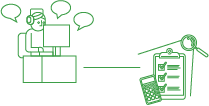The ATO has followed through on plans to improve digitisation of tax reporting and returns, making it mandatory for all employers to use Single Touch Payroll from 1 July 2019.
The legislation, which passed in parliament on February 12, also aims to improve transparency and ensure employee’s rights to superannuation are protected.
 Single Touch Payroll has been a requirement for businesses with 20 or more staff from mid-2018. The new legislation now requires every employer – even those with only one staff member – to use the online reporting system from July this year.
Single Touch Payroll has been a requirement for businesses with 20 or more staff from mid-2018. The new legislation now requires every employer – even those with only one staff member – to use the online reporting system from July this year.
Employees include full-time, part-time, casual, overseas, absent, and seasonal staff employed by your business. It does not include independent contractors, staff provided through labour hire, or company directors or officeholders.
What you need to know about Single Touch Payroll
Traditionally, payroll is reported through your Business Activity Statement (BAS) at the end of each quarter.
The Single Touch Payroll change means that this information is reported in real time; that is, every time you do a pay cycle. Your pay cycle does not need to change – you can still pay employees weekly, fortnightly or monthly as you choose.
The Single Touch Payroll system automatically reports:
- Salaries and wages
- Pay As You Go (PAYG) withholding
- Superannuation information
As reporting is digital and in real time, you may not need to provide a payment summary to employees at the end of the financial year (for certain payments). The ATO plans to pre-populate this information for employees which can be accessed through their myGov account. Employees should also be able to view year-to-date tax and superannuation information in myGov.
In the future, the ATO also plans to digitise employee forms including Tax file number declaration, Superannuation standard choice form, and Withholding declaration. This should make the process of onboarding new employees faster and simpler for all employers.
How Single Touch Payroll works
How Single Touch Payroll affects you
In anticipating this change in legislation, the team at RSM has been actively reminding clients and the broader business community of their obligations, and helping them get their accounting systems in order.
This includes:
- understanding the requirements and compliance obligations
- moving accounting records to the appropriate platforms
- setting up Single Touch Payroll so it works automatically
Remember, Single Touch Payroll does not affect how and when you pay your employees – only how you report those payments. It also does not affect when your PAYG payment is due.
How to prepare for Single Touch Payroll
What you need to do
If you do not have Single Touch Payroll, and you have employees, you will need to implement this change by 1 July 2019.
For some clients, the change may require a simple set-up in their existing accounting system. For others, it may require moving away from, or altering, legacy accounting methods to enable the Single Touch Payroll feature to work.
Either way, it’s important to get professional advice on how to implement Single Touch Payroll for your business, so you can meet your obligations in time.
Ensuring compliance with Single Touch Payroll
FOR MORE INFORMATION
For help with the transition to Single Touch Payroll or for more information, please get in contact with your local RSM STP specialist.
